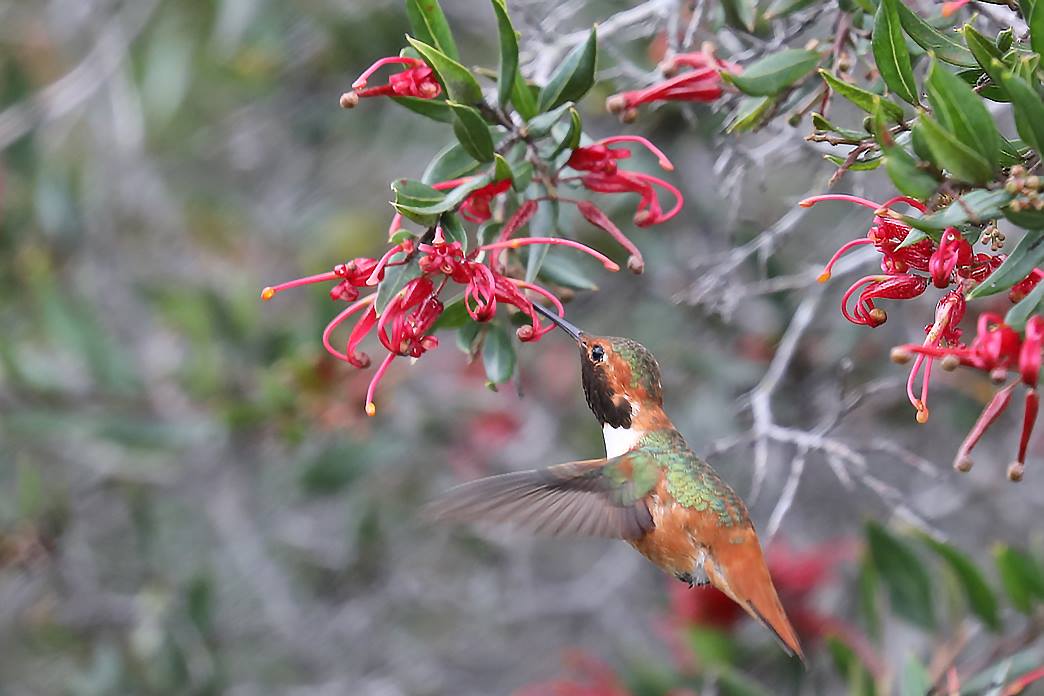Hummingbird Month
March is Hummingbird Month at the Arboretum
This time of year the Arboretum hosts both Anna’s and Allen’s hummingbirds, the two most common species in Northern California. “The density of hummingbirds—the number per area in the Arboretum—is ridiculously high,” says Bruce Lyon, professor of Ecology and Evolutionary Biology at UCSC. “You can watch them feeding on flowers, you can watch their courtship, you can watch them chasing different species. It’s a great opportunity to see some pretty amazing hummingbird biology.”
The Arboretum is home to an abundance of native and exotic plants that attract hummingbirds! In fact, there are many bird species that rely upon the Arboretum for food, shelter and raising young - learn more on our Birding at the Arboretum webpage.
Calendar of events for 2025
3/1/25: First Saturday Tour ~ Birds & Blooms with Clive Bagshaw 11am
3/4/25: Community Day - Free Admission to all (self-guided exploration) 9am-5pm
3/8/25: Meet with Kevin Lohman in the garden: tips & tricks for photographing birds (informal) 9-11am
3/15/25: Early Bird Members Hours: members-only early access (self-guided exploration) 7-9am
3/16/25: Lecture: Encouraging Conservation Through Wildlife Photography with Kevin Lohman 1pm
3/30/25: Lecture: Jewels in the garden: a Darwinian natural history of hummingbirds with Bruce Lyon 1pm
See our guest lecturer bios and additional event information in the March Is Hummingbird Month email update.
Learn more about hummingbirds:

Anna’s Hummingbird (Brad Lewis)
Anna’s hummingbird was named for Princess Anna de Belle Massena, a 19th Century Italian Duchess. Though John James Audubon was allegedly smitten with her, it was naturalist René Primevère Lesson who christened the bird in her honor. While the females are mostly green, the males have an iridescent magenta crown and gorget. The Anna's has a single J shaped dive. The Anna’s hummingbird was recently declared the fastest animal on the planet, relative to its size. They can reach speeds of 50mph, or nearly 385 body lengths per second, a Eurofighter's top speed of 1,320mph jet manages to cover just 39 body lengths per second.

Allen's Hummingbird (Ferd Bergholz)
Allen’s hummingbird (pictured at right) was named for the American collector and taxidermist Charles Andrew Allen (1841-1930). The male has a green back and forehead, rust-colored body and tail, and an iridescent orange-red throat. While the mostly green females have whitish throats with dark speckles and their tail has white tips. The males offer Arboretum visitors a spectacular sight: as part of the mating ritual, they fly in a frantic up and down U-shape that culminates with a high-speed dive.
Behavior of a bird is another “tell”: Allen's and Anna's have overlapping territories - Allen's tend to dominate territories when seasonally migrating. The year-round Anna's fly in low to feed and try to go unnoticed, during this time of territorial overlap.

As you meander through the gardens, it’s helpful to know the “parts” of a hummingbird. A bright-colored area on the throat and chin is called a “gorget” (not seen on females), and a bright-colored area on the forehead and crown is called the “helmet.” The tail offers a clue if it has white or rufous (orange-colored) spots and, if so, their size and location. The bill can identify the species if unusually long, relatively short, or colored red.
